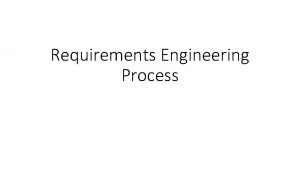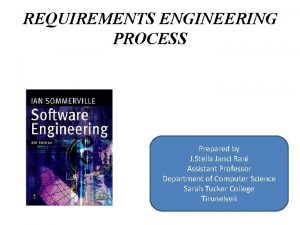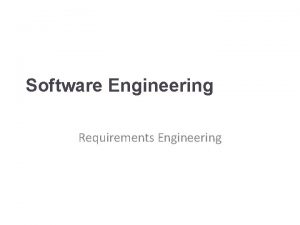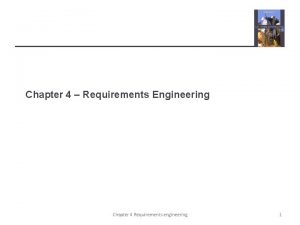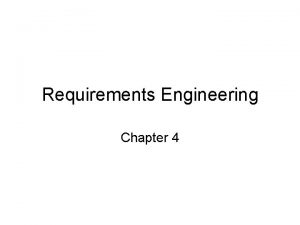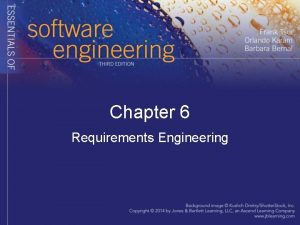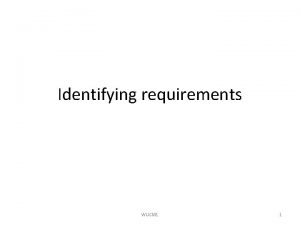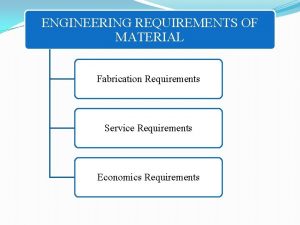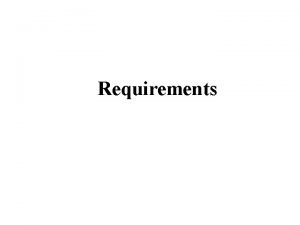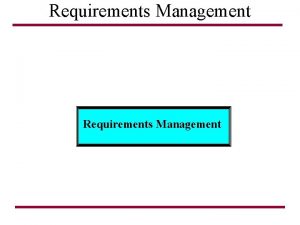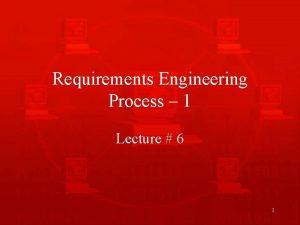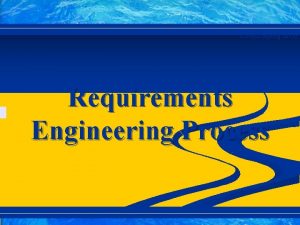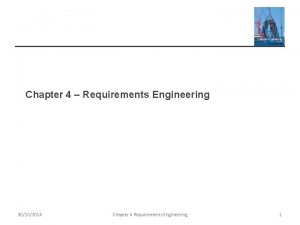Chapter 3 Requirements Engineering Requirements Engineering The process





























- Slides: 29

Chapter 3 Requirements Engineering

Requirements Engineering The process of establishing the services that the customer requires from a system and the constraints under which it operates and is developed. The requirements themselves are the descriptions of the system services and constraints that are generated during the requirements engineering process. Requirements Engineering Chapter 3 2

Types of Requirement User requirements Statements in natural language plus diagrams of the services the system provides and its operational constraints. Written for customers. System requirements A structured document setting out detailed descriptions of the system’s functions, services and operational constraints. Defines what should be implemented so may be part of a contract between client and contractor. Requirements Engineering Chapter 3 3

User And System Requirements Mental Health Care Patient Management System (MHC-PMS) shows how a user requirement may be expanded into several system requirements. You can see from Figure 3. 1 that the user requirement is quite general. The system requirements provide more specific. 1. The MHC-PMS shall generate monthly management reports showing the cost of drugs prescribed by each clinic during that month. 1. 1 On the last working day of each month, a summary of the drugs prescribed, their cost, and the prescribing clinics shall be generated. 1. 2 The system shall automatically generate the report for printing after 17. 30 on the last working day of the month. 1. 3 A report shall be created for each clinic and shall list the individual drug names, the total number of prescriptions, the number of doses prescribed, and the total cost of the prescribed drugs. 1. 4 If drugs are available in different dose units (e. g. , 10 mg, 20 mg) separate reports shall be created for each dose unit. 1. 5 Access to all cost reports shall be restricted to authorized users listed on a management access control list. Figure 3. 1 User And System Requirements Engineering Chapter 3 4

User Requirements System Requirements Client Managers System End-Users Client Engineers Contractor Managers System Architects System End-Users Client Engineers System Architects Software Developers Figure 3. 2 Readers of different types of requirements specification Requirements Engineering Chapter 3 5

3. 1 Functional and Non-Functional Requirements 1. Functional requirements: These are statements of services the system should provide, how the system should react to particular inputs, and how the system should behave in particular situations. In some cases, the functional requirements may also explicitly state what the system should not do. 2. Non-functional requirements: These are constraints on the services or functions offered by the system. They include timing constraints, constraints on the development process, and constraints imposed by standards. Non-functional requirements often apply to the system as a whole, rather than individual system features or services. Requirements Engineering Chapter 3 6

3. 1. 1 Functional Requirements The functional requirements for a system describe what the system should do. These requirements depend on the type of software being developed, the expected users of the software, and the general approach taken by the organization when writing requirements. When expressed as user requirements, functional requirements are usually described in an abstract way that can be understood by system users. However, more specific functional system requirements describe the system functions, its inputs and outputs, exceptions, etc. , in detail. Requirements Engineering Chapter 3 7

Functional Requirements for the MHC-PMS 1. A user shall be able to search the appointments lists for all clinics. 2. The system shall generate each day, for each clinic, a list of patients who are expected to attend appointments that day. 3. Each staff member using the system shall be uniquely identified by his or her 8 -digit employee number. Requirements Engineering Chapter 3 8

Requirements Completeness And Consistency In principle, requirements should be both complete and consistent. Complete: They should include descriptions of all facilities required. Consistent: There should be no conflicts or contradictions in the descriptions of the system facilities. In practice, it is impossible to produce a complete and consistent requirements document. Requirements Engineering Chapter 3 9

3. 1. 2 Non-functional Requirements Non-functional requirements are requirements that are not directly concerned with the specific services delivered by the system to its users. They may relate to emergent system properties such as reliability, response time, and store occupancy. Alternatively, they may define constraints on the system implementation such as the capabilities of I/O devices or the data representations used in interfaces with other systems. Non-functional requirements, such as performance, security, or availability, usually specify or constrain characteristics of the system as a whole. Non-functional requirements are often more critical than individual functional requirements. However, failing to meet a non-functional requirement can mean that the whole system is unusable. Requirements Engineering Chapter 3 10

Non-functional Requirements Implementation 1. Non-functional requirements may affect the overall architecture of a system rather than the individual components. For example, to ensure that performance requirements are met, you may have to organize the system to minimize communications between components. 2. A single non-functional requirement, such as a security requirement, may generate a number of related functional requirements that define new system services that are required. In addition, it may also generate requirements that restrict existing requirements. Figure 3. 3 is a classification of non-functional requirements. Requirements Engineering Chapter 3 11

Types Of Nonfunctional Requirement Non-Functional Requirements : Product Requirements Efficiency Requirements Usability Requirements Performance Requirements Dependability Requirements Security Requirements Environmental Requirements Space Requirements External Requirements Organizational Requirements Security Requirements Ethical Requirements Development Requirements Operational Requirement Accounting Requirements Legislative Requirements Safety/Security Requirements Figure 3. 3 Types of Non-Functional Requirements Engineering Chapter 3 12

Non-functional Classifications 1. Product requirements: These requirements specify or constrain the behavior of the software. Examples include performance requirements on how fast the system must execute and how much memory it requires, reliability requirements that set out the acceptable failure rate, security requirements, and usability requirements. 2. Organizational requirements: These requirements are broad system requirements derived from policies and procedures in the customer’s and developer’s organization. Examples include operational process requirements that define how the system will be used, development process requirements that specify the programming language, the development environment or process standards to be used, and environmental requirements that specify the operating environment of the system. 3. External requirements: This broad heading covers all requirements that are derived from factors external to the system and its development process. These may include regulatory requirements that set out what must be done for the system to be approved for use by a regulator, such as a central bank; legislative requirements that must be followed to ensure that the system operates within the law; and ethical requirements that ensure that the system will be acceptable to its users and the general public. Requirements Engineering Chapter 3 13

Examples of Nonfunctional Requirements in the MHC-PMS Requirements Engineering Chapter 3 14

Metrics for specifying Non-functional Requirements Property Measure Speed Processed transactions/second User/event response time Screen refresh time Size Mbytes Number of ROM chips Ease of use Training time Number of help frames Reliability Mean time to failure Probability of unavailability Rate of failure occurrence Availability Robustness Time to restart after failure Percentage of events causing failure Probability of data corruption on failure Portability Percentage of target dependent statements Number of target systems Figure 3. 5 Requirements Engineering Chapter 3 15

3. 2 The Software Requirements Document The software requirements document is the official statement of what is required of the system developers. Should include both a definition of user requirements and a specification of the system requirements. It is NOT a design document. As far as possible, it should set of WHAT the system should do rather than HOW it should do it. The requirements document has a diverse set of users, ranging from the senior management of the organization that is paying for the system to the engineers responsible for developing the software. Figure 3. 6, shows possible users of the document and how they use it. Requirements Engineering Chapter 3 16

Users of a Requirements Document Figure 3. 6 Requirements Engineering Chapter 3 17

The Structure of a Requirements Document Chapter Description Preface This should define the expected readership of the document and describe its version history, including a rationale for the creation of a new version and a summary of the changes made in each version. Introduction This should describe the need for the system. It should briefly describe the system’s functions and explain how it will work with other systems. It should also describe how the system fits into the overall business or strategic objectives of the organization commissioning the software. Glossary This should define the technical terms used in the document. You should not make assumptions about the experience or expertise of the reader. User requirements Here, you describe the services provided for the user. The nonfunctional definition system requirements should also be described in this section. This description may use natural language, diagrams, or other notations that are understandable to customers. Product and process standards that must be followed should be specified. System architecture This chapter should present a high-level overview of the anticipated system architecture, showing the distribution of functions across system modules. Architectural components that are reused should be highlighted. Requirements Engineering Chapter 3 18

The Structure of a Requirements Document Chapter Description System requirements specification This should describe the functional and nonfunctional requirements in more detail. If necessary, further detail may also be added to the nonfunctional requirements. Interfaces to other systems may be defined. System models This might include graphical system models showing the relationships between the system components and the system and its environment. Examples of possible models are object models, data-flow models, or semantic data models. System evolution This should describe the fundamental assumptions on which the system is based, and any anticipated changes due to hardware evolution, changing user needs, and so on. This section is useful for system designers as it may help them avoid design decisions that would constrain likely future changes to the system. Appendices These should provide detailed, specific information that is related to the application being developed; for example, hardware and database descriptions. Hardware requirements define the minimal and optimal configurations for the system. Database requirements define the logical organization of the data used by the system and the relationships between data. Index Several indexes to the document may be included. As well as a normal alphabetic index, there may be an index of diagrams, an index of functions, and so on. Figure 3. 7 Requirements Engineering Chapter 3 19

3. 3 Requirements Specification Requirements specification is the process of writing down the user and system requirements in a requirements document. User requirements have to be understandable by end-users and customers who do not have a technical background. System requirements are more detailed requirements and may include more technical information. The requirements may be part of a contract for the system development Requirements Engineering Chapter 3 20

Ways Of Writing A System Requirements Specification Notation Natural language sentences Description The requirements are written using numbered sentences in natural language. Each sentence should express one requirement. Structured natural language The requirements are written in natural language on a standard form or template. Each field provides information about an aspect of the requirement. This approach uses a language like a programming language, but with more abstract features to specify the requirements by defining an operational model of the system. This approach is now rarely used although it can be useful for interface specifications. Graphical models, supplemented by text annotations, are used to define the functional requirements for the system; UML use case and sequence diagrams are commonly used. Design description languages Graphical notations Mathematical specifications These notations are based on mathematical concepts such as finite-state machines or sets. Although these unambiguous specifications can reduce the ambiguity in a requirements document, most customers don’t understand a formal specification. They cannot check that it represents what they want and are reluctant to accept it as a system contract. Figure 3. 8 Requirements Engineering Chapter 3 21

3. 4 Requirements Engineering Processes The processes used for RE vary widely depending on the application domain, the people involved and the organisation developing the requirements. However, there a number of generic activities common to all processes § Requirements elicitation; § Requirements analysis; § Requirements validation; § Requirements management. In practice, RE is an iterative activity in which these processes are interleaved. Requirements Engineering Chapter 3 22

A Spiral View Of The Requirements Engineering Process Figure 3. 9 Requirements Engineering Chapter 3 23

Requirements Elicitation And Analysis Software engineers work with a range of system stakeholders to find out about the application domain, the services that the system should provide, the required system performance, hardware constraints, other systems, etc. Stages include: • Requirements discovery, • Requirements classification and organization, • Requirements prioritization and negotiation, • Requirements specification. Requirements Engineering Chapter 3 24

The Requirements Elicitation And Analysis Process Figure 3. 10 Requirements Engineering Chapter 3 25

Process Activities Requirements discovery • Interacting with stakeholders to discover their requirements. Domain requirements are also discovered at this stage. Requirements classification and organisation • Groups related requirements and organises them into coherent clusters. Prioritisation and negotiation • Prioritising requirements and resolving requirements conflicts. Requirements specification • Requirements are documented and input into the next round of the spiral. Requirements Engineering Chapter 3 26

Problems Of Requirements Analysis • • Stakeholders don’t know what they really want. Stakeholders express requirements in their own terms. Different stakeholders may have conflicting requirements. Organisational and political factors may influence the system requirements. • The requirements change during the analysis process. New stakeholders may emerge and the business environment may change. Requirements Engineering Chapter 3 27

Key Points § Requirements for a software system set out what the system should do and define constraints on its operation and implementation. § Functional requirements are statements of the services that the system must provide or are descriptions of how some computations must be carried out. § Non-functional requirements often constrain the system being developed and the development process being used. § They often relate to the emergent properties of the system and therefore apply to the system as a whole. • The software requirements document is an agreed statement of the system requirements. It should be organized so that both system customers and software developers can use it. Requirements Engineering Chapter 3 28

Key Points § The requirements engineering process is an iterative process including requirements elicitation, specification and validation. § Requirements elicitation and analysis is an iterative process that can be represented as a spiral of activities – requirements discovery, requirements classification and organization, requirements negotiation and requirements documentation. Requirements Engineering Chapter 3 29
 Dfd symbols
Dfd symbols Requirement engineering process
Requirement engineering process User requirement
User requirement Feasibility studies for requirements engineering process
Feasibility studies for requirements engineering process Structured specification
Structured specification Hình ảnh bộ gõ cơ thể búng tay
Hình ảnh bộ gõ cơ thể búng tay Frameset trong html5
Frameset trong html5 Bổ thể
Bổ thể Tỉ lệ cơ thể trẻ em
Tỉ lệ cơ thể trẻ em Chó sói
Chó sói Thang điểm glasgow
Thang điểm glasgow Chúa yêu trần thế alleluia
Chúa yêu trần thế alleluia Môn thể thao bắt đầu bằng từ đua
Môn thể thao bắt đầu bằng từ đua Thế nào là hệ số cao nhất
Thế nào là hệ số cao nhất Các châu lục và đại dương trên thế giới
Các châu lục và đại dương trên thế giới Công thức tính độ biến thiên đông lượng
Công thức tính độ biến thiên đông lượng Trời xanh đây là của chúng ta thể thơ
Trời xanh đây là của chúng ta thể thơ Mật thư anh em như thể tay chân
Mật thư anh em như thể tay chân Làm thế nào để 102-1=99
Làm thế nào để 102-1=99 độ dài liên kết
độ dài liên kết Các châu lục và đại dương trên thế giới
Các châu lục và đại dương trên thế giới Thể thơ truyền thống
Thể thơ truyền thống Quá trình desamine hóa có thể tạo ra
Quá trình desamine hóa có thể tạo ra Một số thể thơ truyền thống
Một số thể thơ truyền thống Cái miệng nó xinh thế chỉ nói điều hay thôi
Cái miệng nó xinh thế chỉ nói điều hay thôi Vẽ hình chiếu vuông góc của vật thể sau
Vẽ hình chiếu vuông góc của vật thể sau Nguyên nhân của sự mỏi cơ sinh 8
Nguyên nhân của sự mỏi cơ sinh 8 đặc điểm cơ thể của người tối cổ
đặc điểm cơ thể của người tối cổ Giọng cùng tên là
Giọng cùng tên là Vẽ hình chiếu đứng bằng cạnh của vật thể
Vẽ hình chiếu đứng bằng cạnh của vật thể

